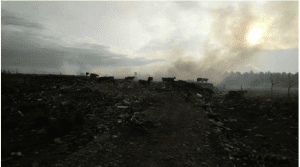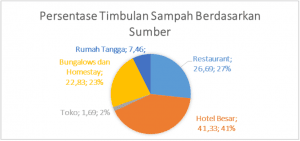Bank Mandiri’s CSR Program in Lombok: Gili Trawangan Bebas Sampah
The Gili Trawangan island that is located in Mataram, North Lombok is one of the tourist destinations whose popularity is rising, and can even compete with Bali.

Based on the interview conducted by Waste4Change’s team with Gili Eco Trust, the total number of tourists in Gili amounts to 1 million people per year for the past 15 years. In addition, the tourists’ growth from both inside and outside the country is around 3,000 to 4,000 people every day.
The increasing number of tourists in Gili correlates with the increasing consumption and production activities, which will ultimately lead to a huge amount of waste that is being generated. Evidently, Gili produces an estimated 9 to 20 tons of waste per day.
The Waste Problem in Gili Trawangan
In general, there are three main problems relating to waste in Gili, which are:
1. The Conventional Collect-Transport-Dispose Method in the Existing Waste Management System, which causes the Waste to be Accumulated in Landfill
To begin with, the number of segregated waste bins that exist in Gili Trawangan is still very little. Hence the local communities did not segregate their waste because with the current waste collection system, it will almost likely get mixed again.



Based on the survey that was conducted in 2016, the average amount of waste that was disposed to Gili Trawangan landfill is as many as 11 tons per day. From that number, only 10%, around 1.100 tons, of waste is recycled by various parties (Gili Eco Trust, Gili Indah waste bank, scavengers, etc).
This condition is also worsened by the lack of further waste management towards the existing waste that had accumulated in the landfill. If nothing is changed, it will not be long until the landfill itself becomes overcapacity.
2. The Society’s Lack of Knowledge in terms of Responsible Waste Management
The people in Gili still see waste as something nasty and dirty. Moreover, they still burn their waste as an effort to reduce the amount of waste that had accumulated in the landfill, as well as to prevent plastic waste from being scattered around and polluting the surrounding areas.



What the people have not yet understood is that the smokes from the activity of burning trash contribute to the greenhouse effect, which is the release of carbon dioxide (CO2) and methane (CH4) gas into the atmosphere. A 2009 Research by McKinsey&Company estimated that Gili Trawangan could release approximately 11 trillion tons of CO2 per day.
3. Limited Availability of Land that Can be Used as Landfill
Making an additional landfill as one of the solutions to the massive amount of waste in Gili is not easy due to the limited availability of the land itself. Many landowners are reluctant to release their land to be made into a landfill. Hence, the government needs to do some land acquisition if they want to make another landfill.



The waste that is generated in Gili Trawangan comes from two main sources, the residential and commercial sectors.
For the residential sector, there are 471 households with a total of 1.709 people distributed into 7 areas/neighborhoods. On another hand, the commercial sector such as hotels, bungalows, homestay, restaurants, as well as stores consists of 442 businesses that are also spread out in 7 areas/neighborhoods.
Based on the waste sampling that was conducted from 10-14th December 2016 in Gili Trawangan landfill, the average amount of waste that was disposed into the landfill is 9.177 kilograms per day.



Another interesting finding is that the waste generated from the commercial sector significantly dominates the total amount of waste as contrasted to the waste that is collected from the residential sector. This emphasizes the huge “role” that tourists have towards the production of waste in Gili. A tourist is estimated to have generated around 3,51 kilograms of waste every single day.
Bank Mandiri’s Bina Lingkungan CSR Program
Waste4Change together with Bank Mandiri developed a waste program to support the implementation of waste management system in Gili Trawangan that is based on the 3R Principles. This program was conducted from November 2016 until August 2017.
The program was funded by Bank Mandiri’s Mataram branch in Lombok as a part of the efforts to implement sustainable tourism practices in Gili Trawangan.
The Challenges that Arise throughout the CSR Program
Realizing a sustainable waste management system in Gili has its own challenges and obstacles due to several factors, namely:
- Geographical Aspect: Gili Trawangan is a small island separated from the mainland. This geographic factor poses some real challenges in the process of building infrastructures and facilities in Gili. For instance, the team needs to rent a barge in order to transport the pickup truck to Gili. In addition, the price of building materials became much more expensive.
- Law and Regulations Aspect: The existing programs and regulations in Gili Trawangan are still in the form of an appeal or recommendation, meaning that it is not yet binding. The supervisions and enforcement of these rules and regulations are also not yet performed strictly. The regulations regarding waste management will be covered by the local regulation (Perda) and North Lombok’s District Regulation, which are still in the development process and not yet issued. The absence of such baselines is what caused North Lombok to not have any budget designated for waste management.
- Cultural Aspect: Many local citizens make a living out of the tourism activities in Gili Trawangan. On the other hand, creating a waste management system requires several fundamental changes from the people itself. Changing people’s way of life and how they do things cannot be done in a short amount of time, especially when they have been doing it for many years.
This exposes a real challenge when we also take into consideration the local customs and beliefs that are still held strongly by the people in di Gili Trawangan.
The Output of the CSR Program in Gili Trawangan
- The making of Gili Trawangan’s Masterplan on Waste Management to be used as a guide in solving the waste issues in Gili Trawangan with a responsible, sustainable, and environmentally friendly approach.
- The Procurement of Vehicles (Cars and Motorcycles) as one of the waste management infrastructures. The modes of transportation that were used in Gili Trawangan were called cidomo (a carriage pulled by a horse), which has its limitations because it depends heavily on the horse’s strength in transporting the load (waste).



Waste4Change then advocated for the procurement of motorcycles and cars to be used in transporting the waste. This appeal was granted and for the first time, the use of cars and motorcycles to collect and transport the waste in Gili Trawangan is allowed.
- Advocation towards the making of an Integrated Waste Management Facilities. Waste4Change took part in advocating the making of an integrated waste management facilities in Gili Trawangan. The facilities is hoped to be able to help in managing the waste that is disposed of in the Gil Trawangan landfill to prevent it from being accumulated, which leads to overcapacity.
It is also hoped that with such waste management facilities, the practice of burning waste will be reduced.



Education and Socialization to both the society and related stakeholders. Waste4Change also conducted education and socialization to the related parties in order for the Gili Trawangan Bebas Sampah program to run effectively. The parties that receive the socialization program are namely business owners (relating to reducing the use of plastic bags), the Gili Trawangan Communication Forum (FKGI), as well as the local government (Pemda KLU).



Responsible Waste Management for a More Sustainable Tourism
Waste production in tourism sites becomes one of the indicators in measuring whether existing tourism practices is already sustainable or not.
If a popular travel destination does not yet have the facilities and system to manage their waste in a responsible and sustainable way, then the consequences will be fatal, both for the environment and for the local communities.
As a social entrepreneur in responsible waste management, Waste4Change supports the implementation of sustainable tourism practices through the service Community-Based Implementation (CBI) program, such as the one conducted in Gili Trawangan along with Bank Mandiri.
Let’s take good care of the beautiful travel destinations that we have so that it doesn’t have to experience overtourism, starting from its waste management aspect.
Read the article in Indonesian version in here.



